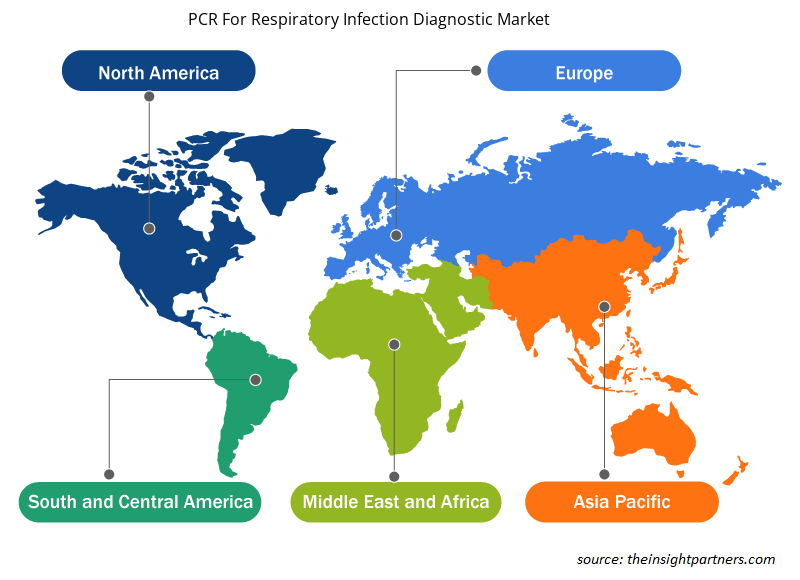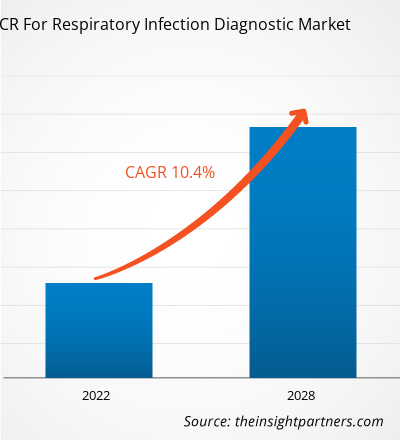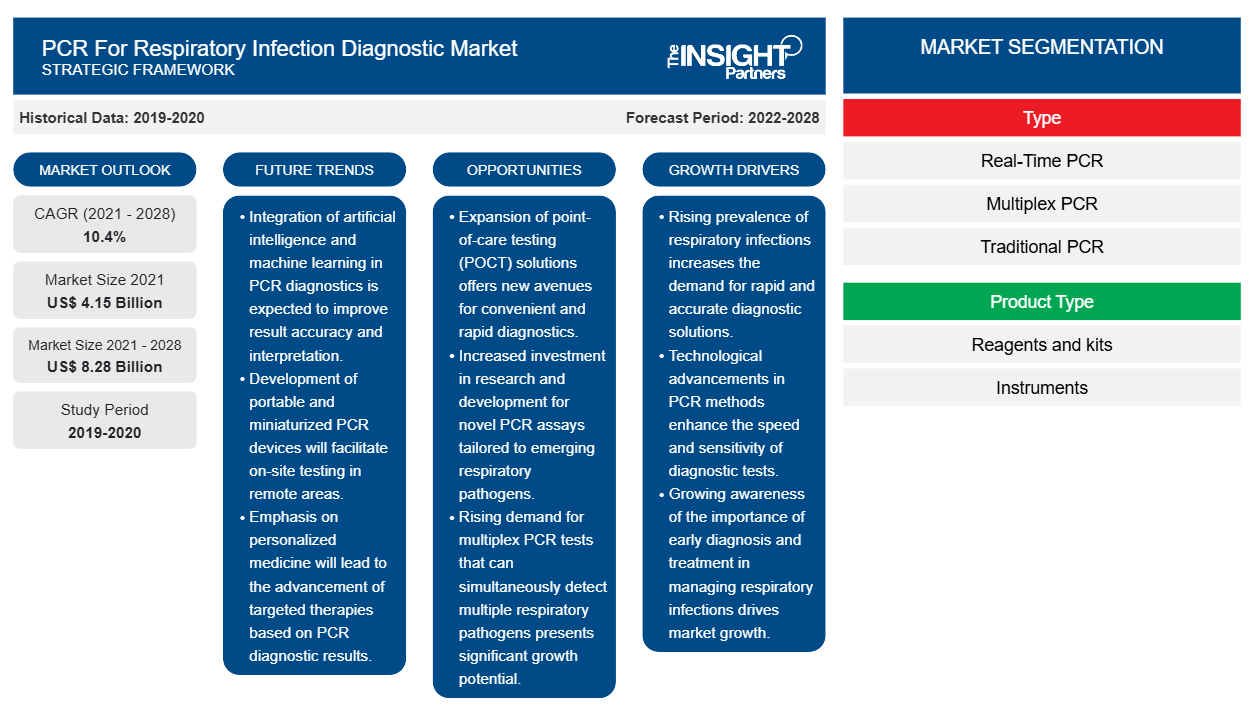بلغت قيمة سوق تقنية تفاعل البوليميراز المتسلسل لتشخيص عدوى الجهاز التنفسي 8279.32 مليون دولار أمريكي بحلول عام 2028 من 4146.02 مليون دولار أمريكي في عام 2021؛ ومن المتوقع أن ينمو بمعدل نمو سنوي مركب قدره 10.4٪ من عام 2021 إلى عام 2028.
تُستخدم تقنية تفاعل البوليميراز المتسلسل (PCR) في التشخيص الدقيق في نقطة الرعاية، مما يساعد على تحديد سبب التهابات الجهاز التنفسي بسرعة. بالإضافة إلى ذلك، تُفضَّل تقنية تفاعل البوليميراز المتسلسل على نطاق واسع في أماكن الرعاية الداخلية والخارجية، مما يساعد على تعزيز نمو السوق في السنوات الأخيرة.
يعود نمو سوق اختبار تفاعل البوليميراز المتسلسل لتشخيص عدوى الجهاز التنفسي إلى عوامل مثل العبء المتزايد لأمراض الجهاز التنفسي المزمنة (CRDs)، والتطورات المتزايدة في اختبار تفاعل البوليميراز المتسلسل، والتي تعمل على تعزيز أداء الأجهزة الطبية على نطاق واسع. ومع ذلك، فإن استخدام اختبار تفاعل البوليميراز المتسلسل لتشخيص عدوى الجهاز التنفسي المختلفة والتطورات في تقنية تفاعل البوليميراز المتسلسل المستخدمة لاستخلاصها. إن توافر الاختبارات البديلة يعيق نمو السوق.
قم بتخصيص هذا التقرير ليناسب متطلباتك
ستحصل على تخصيص لأي تقرير - مجانًا - بما في ذلك أجزاء من هذا التقرير، أو تحليل على مستوى الدولة، وحزمة بيانات Excel، بالإضافة إلى الاستفادة من العروض والخصومات الرائعة للشركات الناشئة والجامعات
- احصل على أهم اتجاهات السوق الرئيسية لهذا التقرير.ستتضمن هذه العينة المجانية تحليلاً للبيانات، بدءًا من اتجاهات السوق وحتى التقديرات والتوقعات.
رؤى السوق
استراتيجيات توحيد السوق المعتمدة باستخدام اختبار تفاعل البوليميراز المتسلسل لتشخيصات عدوى الجهاز التنفسي المختلفة
يعد اختبار تفاعل البوليميراز المتسلسل هو المعيار الذهبي للكشف عن الأمراض المعدية التنفسية، بما في ذلك فيروس سارس-كوف-2. كما أن التطورات المتزايدة في اختبار تفاعل البوليميراز المتسلسل لا تقتصر على اختبار كوفيد-19. فقد سمحت التطورات التكنولوجية المستمرة للباحثين بتطوير تقنيات تفاعل البوليميراز المتسلسل المتقدمة بتكلفة منخفضة والحد من تعقيداتها. ومن المتوقع أن يعزز اختبار تفاعل البوليميراز المتسلسل قدراته على التشخيص الجزيئي ويعزز دوره في المستقبل مع التطورات المستمرة في التقنيات مثل الموائع الدقيقة والتسلسل الجيني للجيل التالي . بالإضافة إلى ذلك، يتم استخدام اختبار تفاعل البوليميراز المتسلسل بشكل كبير في المؤسسات مثل دور رعاية المسنين ومرافق الرعاية المزمنة والمستشفيات، لتحديد عدوى فيروس الإنفلونزا التي تسبب تفشي الجهاز التنفسي.
علاوة على ذلك، تعد الالتهابات التنفسية الحادة والمزمنة من بين الأسباب الرئيسية للاعتلالات في البلدان المتقدمة والنامية على مستوى العالم. وتشير التقديرات إلى أن أمراض الجهاز التنفسي الحادة تمثل ما يقرب من 75٪ من إجمالي الاعتلالات الحادة على مستوى العالم. لذلك، تقدم العديد من الشركات مجموعات تفاعل البوليميراز المتسلسل المختلفة التي يمكنها الكشف عن وجود مسببات الأمراض التي تسبب أمراض الجهاز التنفسي. على سبيل المثال، تقدم شركات مثل bioMérieux SA و altona Diagnostics GmbH مجموعة واسعة من مجموعات تفاعل البوليميراز المتسلسل التي يمكنها الكشف عن عدوى الجهاز التنفسي الحادة في الجهاز التنفسي العلوي أو السفلي. وبصرف النظر عن زيادة حالات الإصابة بأمراض الجهاز التنفسي الحادة والمزمنة، من المرجح أن تعمل عوامل أخرى مثل الظروف البيئية والمناخية وتلوث الهواء واكتشاف البكتيريا والفيروسات ومسببات الأمراض الجديدة كفرص نمو حيوية لاختبار تفاعل البوليميراز المتسلسل لتشخيص عدوى الجهاز التنفسي في المستقبل القريب.
رؤى تعتمد على النوع
تم تقسيم سوق تفاعل البوليميراز المتسلسل لتشخيص عدوى الجهاز التنفسي، حسب النوع، إلى تفاعل البوليميراز المتسلسل في الوقت الحقيقي (qPCR)، وتفاعل البوليميراز المتسلسل المتعدد، وتفاعل البوليميراز المتسلسل التقليدي، وتفاعل البوليميراز المتسلسل الرقمي، والنسخ العكسي (RT-PCR)، وغيرها. احتل قطاع تفاعل البوليميراز المتسلسل في الوقت الحقيقي (qPCR) الحصة الأكبر من السوق في عام 2021 ومن المتوقع أن يسجل أعلى معدل نمو سنوي مركب في السوق خلال الفترة المتوقعة.
رؤى تعتمد على نوع المنتج
بناءً على نوع المنتج، يتم تقسيم سوق تفاعل البوليميراز المتسلسل لتشخيص عدوى الجهاز التنفسي إلى كواشف ومجموعات وأدوات وغيرها. احتل قطاع الكواشف والمجموعات الحصة الأكبر من السوق في عام 2021 ومن المتوقع أن يسجل أعلى معدل نمو سنوي مركب في السوق خلال فترة التوقعات.
رؤى تعتمد على نوع العدوى
بناءً على نوع العدوى، يتم تقسيم سوق PCR لتشخيص عدوى الجهاز التنفسي إلى عدوى بكتيرية وعدوى فيروسية وفطريات ومسببات أمراض أخرى. في عام 2021، احتل قطاع العدوى الفيروسية الحصة الأكبر من السوق ومن المتوقع أن يسجل أعلى معدل نمو سنوي مركب في السوق خلال فترة التوقعات.
رؤى تعتمد على المستخدمين النهائيين
بناءً على المستخدم النهائي، يتم تقسيم سوق PCR لتشخيص عدوى الجهاز التنفسي إلى المستشفيات والعيادات الطبية والمختبرات السريرية والمؤسسات الأكاديمية والبحثية وشركات التكنولوجيا الحيوية والأدوية وغيرها. في عام 2020، احتل قطاع المختبرات السريرية الحصة الأكبر من السوق ومن المتوقع أن يسجل أعلى معدل نمو سنوي مركب في السوق خلال فترة التوقعات.
تعد عمليات إطلاق المنتجات والموافقة عليها من الاستراتيجيات التي تتبناها الشركات بشكل شائع لتوسيع نطاق وجودها العالمي ومحافظ منتجاتها. علاوة على ذلك، يركز لاعبو سوق إعادة بناء الثدي على استراتيجية التعاون لتوسيع قاعدة عملائهم، مما يسمح لهم بدوره بالحفاظ على اسم علامتهم التجارية عالميًا.
رؤى إقليمية حول سوق تقنية تفاعل البوليميراز المتسلسل لتشخيص عدوى الجهاز التنفسي
لقد قام المحللون في Insight Partners بشرح الاتجاهات والعوامل الإقليمية المؤثرة على سوق PCR لتشخيص عدوى الجهاز التنفسي طوال فترة التوقعات بشكل شامل. يناقش هذا القسم أيضًا قطاعات سوق PCR لتشخيص عدوى الجهاز التنفسي والجغرافيا في جميع أنحاء أمريكا الشمالية وأوروبا ومنطقة آسيا والمحيط الهادئ والشرق الأوسط وأفريقيا وأمريكا الجنوبية والوسطى.

- احصل على البيانات الإقليمية المحددة لسوق اختبار تفاعل البوليميراز المتسلسل لتشخيص عدوى الجهاز التنفسي
نطاق تقرير سوق تقنية تفاعل البوليميراز المتسلسل لتشخيص عدوى الجهاز التنفسي
| سمة التقرير | تفاصيل |
|---|---|
| حجم السوق في عام 2021 | 4.15 مليار دولار أمريكي |
| حجم السوق بحلول عام 2028 | 8.28 مليار دولار أمريكي |
| معدل النمو السنوي المركب العالمي (2021 - 2028) | 10.4% |
| البيانات التاريخية | 2019-2020 |
| فترة التنبؤ | 2022-2028 |
| القطاعات المغطاة | حسب النوع
|
| المناطق والدول المغطاة | أمريكا الشمالية
|
| قادة السوق وملفات تعريف الشركات الرئيسية |
|
كثافة اللاعبين في سوق تقنية تفاعل البوليميراز المتسلسل لتشخيص عدوى الجهاز التنفسي: فهم تأثيرها على ديناميكيات الأعمال
يشهد سوق PCR لتشخيص عدوى الجهاز التنفسي نموًا سريعًا، مدفوعًا بالطلب المتزايد من المستخدم النهائي بسبب عوامل مثل تفضيلات المستهلكين المتطورة والتقدم التكنولوجي والوعي الأكبر بفوائد المنتج. ومع ارتفاع الطلب، تعمل الشركات على توسيع عروضها والابتكار لتلبية احتياجات المستهلكين والاستفادة من الاتجاهات الناشئة، مما يؤدي إلى زيادة نمو السوق.
تشير كثافة اللاعبين في السوق إلى توزيع الشركات أو المؤسسات العاملة في سوق أو صناعة معينة. وهي تشير إلى عدد المنافسين (اللاعبين في السوق) الموجودين في مساحة سوق معينة نسبة إلى حجمها أو قيمتها السوقية الإجمالية.
الشركات الرئيسية العاملة في سوق PCR لتشخيص عدوى الجهاز التنفسي هي:
- أبوت
- شركة ف. هوفمان-لاروش
- شركة هولوجيك
- شركة سيجين
- التشخيص الأسترالي
إخلاء المسؤولية : الشركات المذكورة أعلاه ليست مرتبة بأي ترتيب معين.

- احصل على نظرة عامة على أفضل اللاعبين الرئيسيين في سوق تشخيص عدوى الجهاز التنفسي PCR
حسب النوع
- تفاعل البوليميراز المتسلسل في الوقت الحقيقي (qPCR)
- تفاعل البوليميراز المتسلسل المتعدد
- تفاعل البوليميراز المتسلسل التقليدي
- تفاعل البوليميراز المتسلسل الرقمي
- النسخ العكسي (RT-PCR)
- آحرون
حسب نوع المنتج
- الكواشف والمجموعات
- الآلات الموسيقية
- آحرون
حسب نوع العدوى
- العدوى البكتيرية
- بورديتيلا
- العقدية الرئوية
- المكورات العنقودية الذهبية
- المستدمية النزلية
- موراكسيلا كاتاراليس
- الميكوبلازما الرئوية
- الكلاميدوفيلا الرئوية
- الليجيونيلا
- آحرون
- العدوى الفيروسية
- فيروسات الأنف
- فيروس الانفلونزا
- فيروس متلازمة الالتهاب الرئوي الحاد الوخيم (سارس) CoV-2
- الفيروس المخلوي التنفسي (RSV)
- الفيروس الغدي
- فيروس معوي
- نظير الانفلونزا
- الفيروس الرئوي البشري (hMPV)
- آحرون
- الفطريات ومسببات الأمراض الأخرى
حسب المستخدم النهائي
- المستشفيات
- عيادات الأطباء
- المختبرات الطبية
- المؤسسات الأكاديمية والبحثية
- شركات التكنولوجيا الحيوية والأدوية
- آحرون
حسب الجغرافيا
- أمريكا الشمالية
- نحن
- كندا
- المكسيك
- أوروبا
- فرنسا
- ألمانيا
- المملكة المتحدة
- إسبانيا
- هولندا
- النرويج
- إيطاليا
- بقية أوروبا
- آسيا والمحيط الهادئ (APAC)
- الصين
- الهند
- اليابان
- أستراليا
- كوريا الجنوبية
- بقية آسيا والمحيط الهادئ
- الشرق الأوسط وأفريقيا
- المملكة العربية السعودية
- الامارات العربية المتحدة
- جنوب أفريقيا
- بقية الشرق الأوسط وأفريقيا
- أمريكا الجنوبية والوسطى (SCAM)
- البرازيل
- الأرجنتين
- بقية أمريكا الجنوبية والوسطى
نبذة عن الشركة
- أبوت
- شركة ف. هوفمان-لاروش
- شركة هولوجيك
- شركة سيجين
- التشخيص الأسترالي
- بنغلاديش
- مختبرات بيو راد
- بيوميريوكس
- كياجن
- شركة ثيرمو فيشر العلمية
- التحليل التاريخي (سنتان)، سنة الأساس، التوقعات (7 سنوات) مع معدل النمو السنوي المركب
- تحليل PEST و SWOT
- حجم السوق والقيمة / الحجم - عالمي، إقليمي، بلد
- الصناعة والمنافسة
- مجموعة بيانات إكسل
التقارير الحديثة
شهادات العملاء
سبب الشراء
- اتخاذ قرارات مدروسة
- فهم ديناميكيات السوق
- تحليل المنافسة
- رؤى العملاء
- توقعات السوق
- تخفيف المخاطر
- التخطيط الاستراتيجي
- مبررات الاستثمار
- تحديد الأسواق الناشئة
- تحسين استراتيجيات التسويق
- تعزيز الكفاءة التشغيلية
- مواكبة التوجهات التنظيمية





















 احصل على عينة مجانية ل - سوق تشخيص عدوى الجهاز التنفسي بتقنية تفاعل البوليميراز المتسلسل (PCR)
احصل على عينة مجانية ل - سوق تشخيص عدوى الجهاز التنفسي بتقنية تفاعل البوليميراز المتسلسل (PCR)